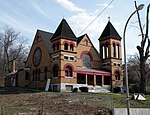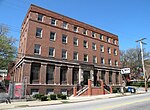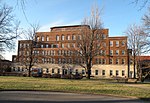Pitt Township, Allegheny County, Pennsylvania
1788 establishments in Pennsylvania1868 disestablishments in PennsylvaniaAllegheny County, Pennsylvania geography stubsFormer townships in Allegheny County, PennsylvaniaPittsburgh stubs ... and 2 more
Populated places disestablished in 1868Populated places established in 1788
Pitt Township was one of the original townships created with the formation of Allegheny County, Pennsylvania in 1788. It repeatedly diminished in size until dissolving into the city of Pittsburgh in 1868.
Excerpt from the Wikipedia article Pitt Township, Allegheny County, Pennsylvania (License: CC BY-SA 3.0, Authors).Pitt Township, Allegheny County, Pennsylvania
Wylie Avenue, Pittsburgh
Geographical coordinates (GPS) Address Nearby Places Show on map
Geographical coordinates (GPS)
| Latitude | Longitude |
|---|---|
| N 40.45 ° | E -79.966666666667 ° |
Address
Wylie Avenue 2846
15219 Pittsburgh
Pennsylvania, United States
Open on Google Maps







